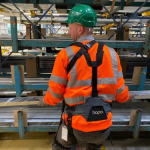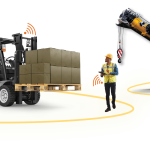News - Construction News
Ensuring Safety and Justice in the Workplace

Ensuring Safety and Justice in the Workplace: A Call for Employer Responsibility and Employee Protection
By Jonathan White, Legal and Compliance Director at National Accident Helpline
Last month, a construction company was fined £550,000 over the death of a worker who was impaled on metal piping whilst working at a train station, according to the Crown Office.
In a 14-day trial, prosecutors argued the firm had failed to assess risks and put in place a safe system of work. As a result, Sheffield-based Linbrooke Services Limited was found guilty at Dumbarton Sheriff Court of three offences and was also ordered to pay £200,000 to the worker’s family in compensation.
This recent tragic incident, which resulted in the foreseeable and avoidable death of a construction worker has once again brought workplace safety into sharp focus.
It is an employer’s duty to promote a culture of health and safety and follow the right procedures to prevent their employees from suffering injuries at work. Employers should consider practical measures to prevent similar incidents, as well as paying close attention to the Work at Height regulations and guidance issued by the Health & Safety Executive. Falls from height are one of the most common causes of workplace fatalities and the focus on taking all reasonable steps to avoid these incidents is understandable.
How can employers avoid similar incidents happening in the future?
It is the moral and legal duty of employers to prioritise the safety and well-being of their employees. To avoid similar incidents, employers should implement the following measures:
Robust Health and Safety Policies: Employers must develop comprehensive health and safety policies tailored to their specific industry and work environments. Regularly reviewing and updating these policies is essential to address evolving risks.
Adequate Training and Supervision: Employers must ensure that workers receive proper training on safety procedures, hazard identification, and the correct use of protective equipment. As training in the environment of a construction site is often carried out on the job, it is essential that if someone is being trained, they are supervised by someone who is competent to do so. Regular refresher courses and ongoing supervision are vital to reinforcing safe practices at work.
Thorough Risk Assessments: Regular and thorough risk assessments are also crucial for identifying potential hazards and implementing appropriate control measures. Employers should involve employees in this process to gain valuable insights and foster a culture of safety.
Effective Communication: Open lines of communication between management and employees are vital to ensure that safety concerns are promptly reported and addressed. Encouraging a proactive reporting culture can help prevent accidents before they occur.
Continuous Improvement: Employers should establish a culture of continuous improvement by learning from near misses and incidents. Conducting investigations, implementing corrective measures, and sharing lessons learned across the organisation can significantly enhance workplace safety.
How can employees claim compensation for an injury suffered through an accident at work?
When an employee suffers an injury due to an accident at work, they are entitled to seek compensation for their physical, emotional, and financial losses. Here’s a brief overview of the steps employees can take:
Report the Incident: Immediately report the accident to a supervisor or the designated authority within the organisation and ensure that a written record of the incident is created.
Seek Medical Attention: Receive prompt medical attention for the injury and keep a record of all the treatment, care and expenses related to the accident.
Gather Evidence: Collect and preserve evidence such as photographs, the names of witnesses and any other relevant information that can be used to prove what happened.
Consult Legal Advice: Contact a reputable personal injury lawyer who specialises in workplace accidents. They can guide employees through the legal process, evaluate the claim’s viability, and provide support throughout. Most law firms specialising in this area will undertake an initial assessment as to whether there is a claim, which is almost always done for free.
Initiate the Claim: If there is a claim worth pursuing, most law firms will offer to support the claim on a no-win, no-fee basis. The lawyer will help file the necessary paperwork and seek to establish if the employer was at fault for the accident. If so, they will gather evidence before negotiating with the employer’s insurance company to secure fair compensation for the employee’s losses, including medical expenses, lost wages, and pain and suffering.
Our National Accident Helpline survey found that nearly half of working Brits (44%) worry they could their job if they make a claim against their employer. However, employees should feel assured that it’s illegal to fire employees for making a personal injury claim.
What is the Working from Height regulation and what does it mean if it were to be removed from law?
The Work at Height regulations are a crucial piece of legislation aimed at protecting workers who perform tasks at heights. The regulations apply if someone is working on a ladder, a flat roof or where fragile surfaces are present but also where workers could fall into an opening in the floor or a hole in the ground. If this regulation were to be removed, it would reduce the burden on employers to keep employees safe resulting in an increased risk of accidents and reduced safety standards.
Removing the Work at Height regulations would diminish the legal framework that ensures employers prioritise worker safety when working at elevated positions. This could lead to a rise in accidents, injuries, and fatalities.
The removal of the regulation might result in employers neglecting safety measures, such as proper equipment, training, and risk assessments, ultimately compromising worker safety.
Without the protection of this regulation, employees injured in working at height accidents may face difficulties in establishing liability and securing appropriate compensation. It is essential to preserve this regulation to protect the rights and well-being of workers.
If you would like to read more stories like this, then please click here
Related Articles
More News
- Merit Appointed to NHS Shared Business Services Modular Building Framework
1 Jul 25
Merit is pleased to announce its successful appointment to the NHS Shared Business Services (NHS SBS)
- £1Bn backed renewal of broken bridges, ruined roads and tired tunnels
30 Jun 25
The Structures Fund will inject cash into repairing bridges, flyovers and tunnels across Britain.
- £8Bn to be invested in flood defences over the next decade
27 Jun 25
A record £7.9Bn over ten years has been committed to flood defences.






